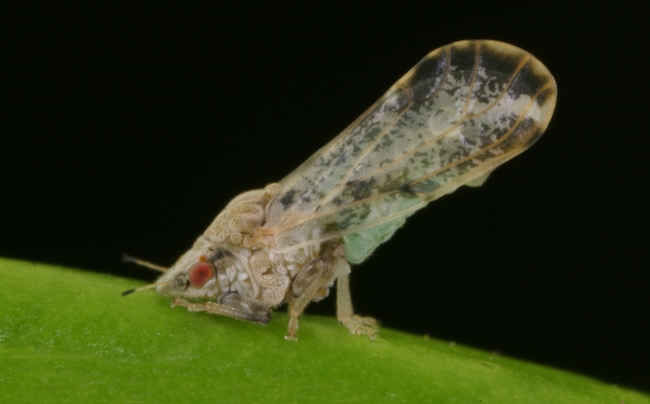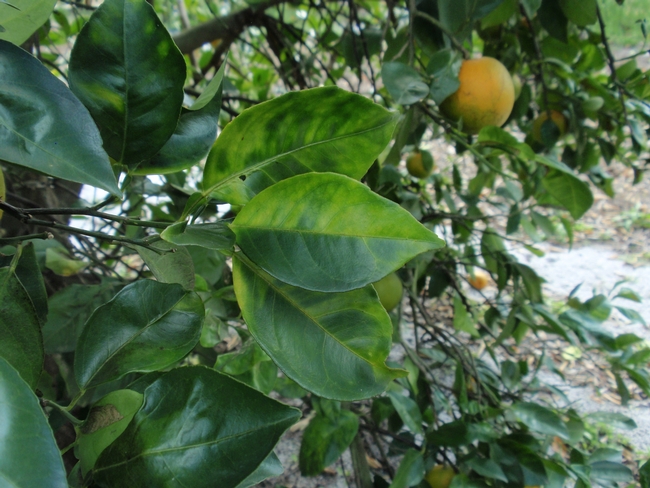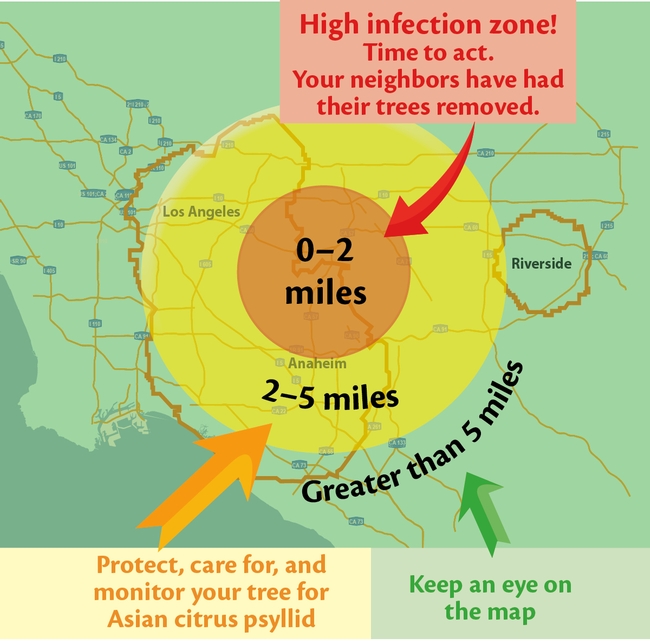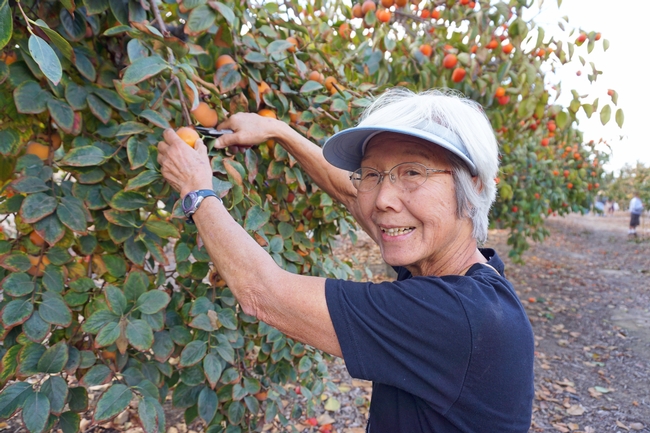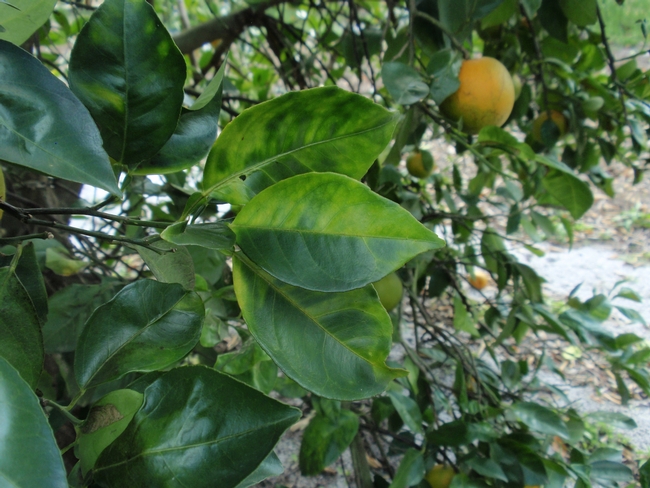Posts Tagged: Asian citrus psyllid
Asian citrus psyllid study: Vigilance urged but ‘no cause for panic’
Preliminary results indicate 3.5% of ACP collected showed signs of bacterium that can cause huanglongbing
An ongoing study in the commercial citrus groves of coastal Southern California is looking at whether Asian citrus psyllids – the insect vector of huanglongbing “citrus greening” disease – are carrying the bacterium that can cause HLB.
Thus far, the project has tested more than 3,000 adult ACP collected from 15 commercial citrus sites across the region, of which 138 – just over 3.5% – had some level of the bacterium present, according to researchers from UC Agriculture and Natural Resources, UC Davis, UC Riverside and the University of Arizona, Tucson.
“While the results are a cause for concern, the situation in California is much better than in Florida and Texas, where ACP carrying the bacterium make up the majority of the population and HLB is widespread in commercial citrus,” said Neil McRoberts, a UC Davis plant pathologist and UC Integrated Pest Management program affiliate advisor. “The results indicate that there is no room for complacency, but also no cause for panic.”
Since the first HLB-infected tree in California was found in 2012, nearly 4,000 infected trees have been detected and removed from residential properties in Southern California, mainly in Orange and Los Angeles counties. According to McRoberts, “to date, no HLB has been found in commercial citrus” in California.
He stressed, however, that the aforementioned ACP study – funded by the HLB Multi Agency Coordination Group and managed by USDA-APHIS – does not involve any testing of trees for HLB and focuses only on looking at the insect which spreads the bacterium.
McRoberts also emphasized that the project's detections of the bacterium cannot be considered “official” because the researchers' lab procedures differ from the official testing protocols of the California Department of Food and Agriculture.
“Follow-up sampling by CDFA staff would allow official samples to be collected for further investigation, but is entirely voluntary for the growers involved,” he said, adding that his research team is currently wrapping up the sampling phase of the project, with data analysis continuing into 2023.
While commending the “huge coordinated effort” by the California citrus industry, California Department of Food and Agriculture, UC ANR and other partners to suppress the ACP vector and slow the spread of HLB, McRoberts also urged continued vigilance.
“Our study results indicate that it is not time to declare the emergency status for ACP/HLB in California over – the situation is still evolving,” he said.
For further information about the research, contact Neil McRoberts at nmcroberts@ucdavis.edu or (530) 752-3248.
Planting alternative backyard fruit trees in Southern California can help stop citrus threat
Southern California's mild Mediterranean climate makes it ideal for growing fruit trees in backyards, community gardens and school gardens. The trees provide wholesome fruit along with shade, beauty and enrichment for families and communities.
“With fresh fruit close at hand, it's easier to follow dietary guidelines that encourage filling half our plates with fruits and vegetables for good health,” said Rachel Surls, UC Cooperative Extension sustainable food systems advisor. “Besides, gardening is a great activity. Tending fruit trees teaches natural science, responsibility and appreciation for fresh food. And a garden gets people outside and engaged in physical activity.”
Citrus trees are favorites for Southern California backyards, but Surls and her team aim to get local gardeners thinking beyond lemons, limes, oranges and other citrus fruit. In the past several years, a deadly plant disease has been spreading among Southern California citrus, prompting quarantines and putting citrus orchards across the state at risk.
Surls and her team are working on an initiative with a corps of volunteer UC Master Gardeners in Los Angeles and surrounding counties to promote selection and planting of appropriate fruit trees. New brochures, a website, workshops and one-on-one consultations will guide Southern Californians in making tree decisions that are scientifically sound and community-focused.
The project addresses serious concerns about the rapid spread of huanglongbing (HLB) disease, also known as citrus greening. The insect that spreads HLB – the Asian citrus psyllid – was introduced into California in 2008. The disease made its first California appearance in a Los Angeles County backyard in 2012. HLB, which eventually kills every tree it infects, is now spreading rapidly in urban areas of Los Angeles and Orange counties, where quarantines have been put in place by the California Department of Food and Agriculture (CDFA).
“Citrus trees are so popular in Southern California. They are part of our history and regional identity,” Surls said. “Now we have the unfortunate responsibility of telling residents about this serious problem we are facing. In some cases, residents who live near infected trees should be proactive and remove their lemon, orange, mandarin and lime trees and replace them with different kinds of fruit.”
New web app shows residents' proximity to HLB disease
University of California Agriculture and Natural Resources IGIS programmers, in collaboration with UC Cooperative Extension, have created an HLB Monitoring Web App that allows residents to enter an address to determine how close they are to confirmed HLB outbreaks. If they are within 2 miles of a residence where an HLB-infected citrus tree was found, the app recommends replacement of citrus trees with non-citrus fruit trees, such as apples, peaches, avocados or persimmons.
Residents with citrus trees that are 2 to 5 miles from areas with HLB should keep a close eye on their trees, treat for Asian citrus psyllid and begin thinking about planting an alternative to citrus if the disease spreads to their area.
“Huanglongbing poses a serious threat to both backyard and commercial citrus in California if its spread is not halted,” Surls said. “By removing trees in areas where HLB has been found, residents are helping reduce its ability to spread, buying time for scientists to find a cure.”
CDFA is testing trees throughout the state and removing HLB-infected trees. However, the first visible symptoms of HLB – yellow mottled leaves – can appear months to years after infection. Even if they look perfectly healthy, citrus trees can be harboring the disease and allowing it to be spread by the tiny psyllid insect.
Current hotspots shown on the HLB Monitoring Web App include Rosemead, Montebello, Pico Rivera, San Gabriel, Hacienda Heights and Cerritos in Los Angeles County. In Orange County, HLB is spreading in communities around Garden Grove, Westminster and Santa Ana.
“We know removing citrus trees is going to be really hard for people,” Surls said. “But if you live within two miles of an infected tree, your tree is probably already infected, and HLB means your tree is going to die.”
To ease the transition, UC Master Gardeners are informing residents about alternatives that will produce fruit that's nutritious and delicious.
“So many types of fruit trees can be grown in Southern California,” Surls said. “Honestly, we have almost unlimited options. We live in a fruit tree grower's paradise. So we want to encourage local residents to think seriously about selecting non-citrus trees to replace their citrus.”
The information can also inform residents who are planning a new backyard orchard.
“They should consider some of the many wonderful fruit trees we can grow here — plant a pomegranate, plant a peach, plant a persimmon — but resist the temptation to plant more lemons, oranges and other citrus trees,” Surls said.
Making the decision to plant a certain type of tree should not be taken lightly.
“Planting a fruit tree is a big commitment. It will be part of your garden for years. Research the best options for your family and locations,” Surls said. “The UC Master Gardeners are here to help.”
Following are good options to consider for replacing citrus trees in Southern California, although recommendations may vary based on local climate:
Apples
Certain apple varieties that do not need to be exposed to cold temperatures grow and produce well in Southern California. Low-chill varieties include Anna, Beverly Hills, Dorset Golden, Fuji and Gala.
Figs
Figs grow well in full sun in Southern California. They can reach 10 to 30 feet tall, and are best for spacious areas.
Jujube
Jujubes are less common in Southern California, but are a valued fruit in Southeast Asian and will grow well under Southern California conditions. They grow about 15 feet tall. Jujubes are a good selection for inland valleys that get hot during the summer. The fruit tastes like small, crispy apples. Dried, they are similar to dates.
Loquat
A small- to medium-size tree that grows 10 to 20 feet high, loquats are easy to grow and have relatively few pests. Fresh, ripe loquats are sweet and aromatic. They can be used in jams, sauces and garnishes.
Persimmon
Persimmons ripen in autumn after the leaves have fallen, creating a beautiful landscape display. They are easy to grow in full sun and part shade. Persimmons can be eaten fresh or dried for a date-like fruit.
Pomegranate
Well-suited to Southern California's Mediterranean climate, pomegranates grow to about 15 feet in height. Pomegranates are pest- and disease-resistant. The fruit's seeds, coated with astringent juicy flesh, are called arils. Use arils to top salads or other dishes, or squeeze for juice or to make jelly.
Other fruit tree options for Southern California include mangos, guavas, pineapple guavas, peaches, nectarines and pears.
For more research-based information about alternative fruit trees, visit the UC Agriculture and Natural Resources website “California Backyard Orchard” at http://homeorchard.ucanr.edu.
Contact your local UC Master Gardener Program for additional advice:
Los Angeles County – http://celosangeles.ucanr.edu/UC_Master_Gardener_Program
Orange County – http://mgorange.ucanr.edu
Riverside County – https://ucanr.edu/sites/RiversideMG
San Bernardino County – http://mgsb.ucanr.edu
Ventura County – https://ucanr.edu/sites/VCMG
Funding for the ‘Alternatives to Citrus Fruit in the Fight against Huanglongbing Disease' project was made possible by the U.S. Department of Agriculture's (USDA) Agricultural Marketing Service through grant AM180100XXXXG003. Its contents are solely the responsibility of the authors and do not necessarily represent the official views of the USDA.
Citrus industry, UC Riverside and UCCE team up to fight a citrus killer
On June 6, citrus industry, university and government leaders gathered at UC Riverside Citrus Variety Collection to announce a joint effort to fight huanglongbing (HLB), also known as citrus greening disease. Huanglongbing is a bacterial plant disease fatal to citrus trees
The effort will result in construction of a biosafety-level 3 plant facility in Riverside, about two miles north of UC Riverside.
The biosafety-level 3 plant facility will allow researchers, including many from UC Riverside who are experts on citrus pests, diseases and breeding, to conduct work with plant pathogens that previously couldn't be done in Southern California. (There is only one other such facility in California – at UC Davis.)
The new biosafety-level 3 building will be built and owned by the California Citrus Research Foundation, which is funded by citrus growers.
At the June 6 gathering, Kim Wilcox, chancellor of the UC Riverside, spoke about the establishment in 1907 of the Citrus Experiment Station in Riverside. That research station eventually grew into UC Riverside. He noted that the research station received a boost after a 1913 freeze that devastated the citrus industry.
“Now, unfortunately, 100 years later, we have a different kind of natural threat, Wilcox said. “It's not weather in this case but an insect. And again the university, the federal government and private partners have come together and said ‘We can address this.'”
Georgios Vidalakis and Mark Hoddle are two UC Cooperative Extension specialists based at UC Riverside who will benefit from the facility.
Vidalakis is a UCCE specialist in plant pathology and director of the Citrus Clonal Protection Program at UC Riverside. The program provides a safe mechanism for the introduction into California of citrus varieties from around the world.
“Having access to live plants that carry the bacteria is very, very important to our program because it allows us to develop and validate diagnostic techniques much more quickly,” Vidalakis said.
Vidalkis has ongoing projects at the biosafety-level 3 plant facility in Davis as well as one in Maryland. Having his experimental material hundreds or thousands of miles away is a difficult, costly and inefficient way to conduct science, he said.
“This new facility in Riverside will help tremendously in the fight against HLB,” he said. “It is also a great investment for future threats to the California citrus industry.”
Hoddle is a UCCE specialist in entomology and director of Center for Invasive Species Research at UC Riverside. In recent years, Hoddle has released two species of wasps native to Pakistan that are natural enemies of the Asian citrus psyllid, the vector of a bacterium that causes HLB.
Hoddle called the biosafety facility a critical resource for righting HLB that will greatly assist UC Riverside researchers.
“This investment will likely allow more rapid and cost effect progress in developing mitigation strategies and novel technologies for managing HLB in California's iconic citrus crop,” Hoddle said.


